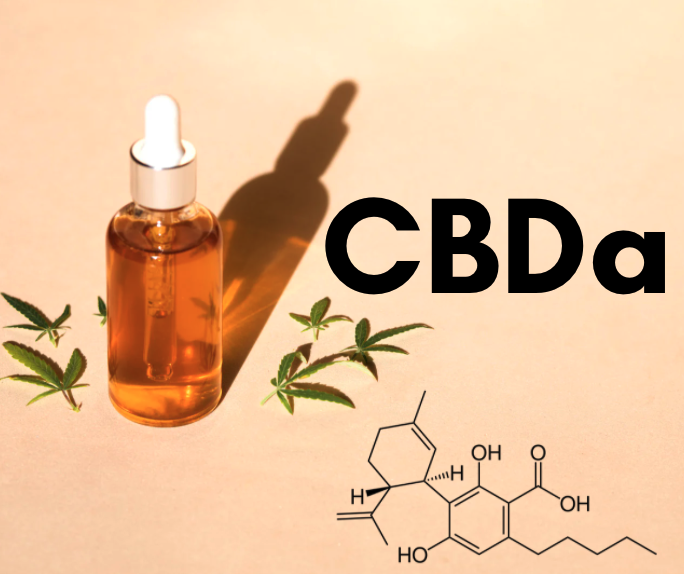
With more than 100 known cannabinoids discovered by scientists, it can be hard for individual compounds to stand out alongside show ponies like THC and CBD. CBDa is one cannabinoid that’s managed to break this trend, with the compound winning attention for its therapeutic and medicinal properties.
Like most cannabinoids which can be a bit of a mouthful to pronounce, an acronym is used to shorten the name. In this case, CBDa stands for Cannabidiolic acid. It’s produced by both cannabis and hemp plants and like other cannabinoids, it actively interacts with the body’s natural endocannabinoid system to produce medical effects, but not in the way you might think.
Intrigued? Read on to find out more about the “raw” cannabinoid and why it’s on our radar.
You’ve probably noticed CBDa and CBD share very similar acronyms and this isn’t a coincidence. In living cannabis plants, CBD is expressed in the form of CBDa. It’s not until buds are trimmed, dried, and exposed to heat that CBD forms. The heating and drying process breaks down the acids found in fresh flowers and transforms them into more potent compounds, such as CBD. While this process is generally helped along by humans, it can also occur naturally as the plant grows, absorbs sunlight, dries out, and starts to deteriorate.
This is known as decarboxylation and essentially converts “raw” CBDa into CBD by removing the acid group. So, CBDa is a direct chemical precursor to CBD and offers many of the same therapeutic benefits. For some people, CBDa is a purer form of enjoying cannabis as it exists in the raw state. Think of it as the difference between cold-pressed juice vs juice produced by centrifugal force. Or fresh vs freeze-dried food.
If you want to go back even further, CBDa is a chemical precursor to CBGA, aka the “mothership” cannabinoid. Its distinguished nickname was inspired by the trio of major cannabinoid compounds that it creates – CBDa, CBCa and THCa. When the latter undergoes decarboxylation, the highly coveted cannabinoid we know as THC is produced.
Now we know a little more about how CBDa is produced, let’s get stuck into why this “raw” cannabinoid has got people talking.
Most cannabinoids, including CBD and THC, interact with the endocannabinoid system via CB1 or CB2 receptors. CBDa does things a little differently and instead inhibits an enzyme known as COX-2, which is associated with inflammation. Naturally, this gives CBDa pretty powerful anti-inflammatory properties. It’s been explored as a treatment for pain associated with arthritis, as well as temporary pain caused by injuries and surgery.
CBDa has also been linked to serotonin, a chemical that stabilizes the mood and helps to regulate sleep, digestion, and other core human functions. Some studies suggest CBDa can interact with the body’s 5-HT receptors, which produce serotonin. This replicates the effects of selective serotonin reuptake inhibitor (SSRI) antidepressant medications, which are widely used to treat depression.
On the flipside, CBDa has also been explored as a therapy to treat side effects caused by stressors such as chemotherapy and radiation. Exposure to these stressors can flood the body with too much serotonin, which can lead to chronic nausea and vomiting. The ability of CBDa to interact with 5-HT receptors has put it on the radar of scientists developing treatments for chemotherapy side effects.
There’s a growing body of evidence to suggest CBDa is a potent anticonvulsive, with the cannabinoid’s high level of bioavailability making it much easier and faster for the body to metabolize. This has made it a cannabinoid of interest for researchers developing treatments for epileptic seizures, as well as migraines, neuropathic pain, and other brain disorders.
While research is in the very early stages, CBDa has also stepped up as a potential breast cancer inhibitor. Initial studies suggest the cannabinoid could prevent the migration of aggressive cells called MDA-MB-231 and prevent the disease from advancing.
While CBDa has infatuated medical and recreational cannabis scientists for decades, a recent study from Oregon State University propelled it into the spotlight. The free-spirited Beaver State has always been a proud supporter of botanicals, so it’s no surprise this cutting-edge research came from the Global Hemp Innovation Center at OSU.
Led by Richard van Breemen, the study found that CBDa actively binds to the SARS-CoV-2 spike protein and prevents the virus from infiltrating cells via the ACE2 enzyme. This put CBDa on the map as an antiviral intervention candidate, with van Breemen maintaining it could be effective at not only shortening the SARS-CoV-2 infection cycle by preventing the virus from multiplying but preventing infection altogether.
“These cannabinoid acids are abundant in hemp and in many hemp extracts,” says van Breemen. “They are not controlled substances like THC, the psychoactive ingredient in marijuana, and have a good safety profile in humans. And our research showed the hemp compounds were equally effective against variants of SARS-CoV-2, including variant B.1.1.7, which was first detected in the United Kingdom, and variant B.1.351, first detected in South Africa.”
While there’s still a lot of research to be done before we can wax lyrical about the antiviral properties of CBDa, it’s a pretty wild study and we can’t wait to see where van Breemen and the OSU take it next.
Think you might be interested in harnessing the therapeutic properties of CBDa? Watch this space. We’re on the cusp of launching a brand new tincture that allows you to enjoy the benefits of CBDa in a format that’s safe and legal. Until now, juicing raw cannabis has been one of the most popular ways to get a fix of CBDa. Obviously, this isn’t the easiest, fastest, or cleanest method of enjoying the cannabinoid. Our brand new CBDa tincture is set to shake things up and make this cannabinoid accessible to everyone, not just those who own a cold press juicer!
© 2022 All rights reserved
Cannessentials LLC